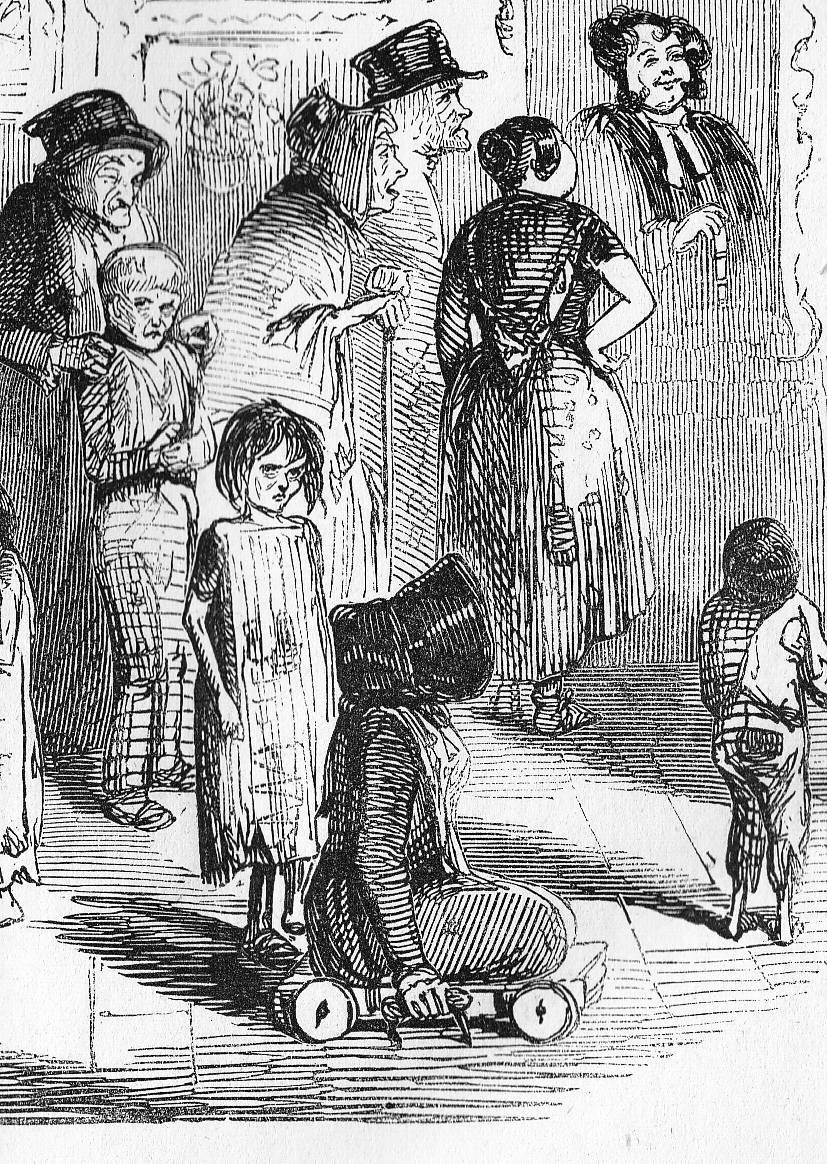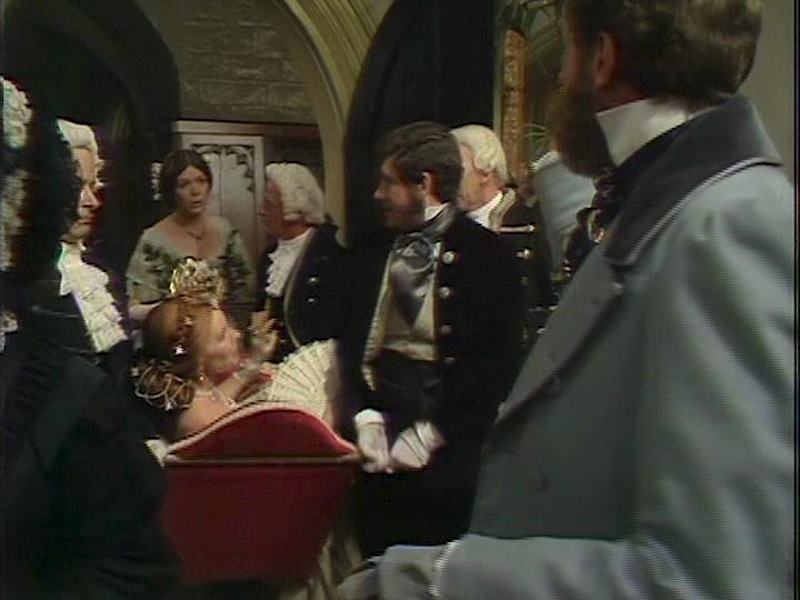Formatted, with the addition of links, illustrations and captions, by Jacqueline Banerjee. Click on the images for larger pictures and (after the first one) for more information.

Martha Stoddard Holmes's examination of depictions of disability in Victorian writing belongs to a type of disability study prevalent before 2005: she treats disability as it "intersects with other theoretical concerns" (see Mounsey 4). She studies how in her chosen era the obviously physically disabled became a familiar focus for saturated melodrama from strongly gendered, ageist, and economic perspectives, bringing out particulars in these depictions that highlight nineteenth-century obsessions about the human body, sexuality, having and bringing up children, and respected remunerative work. She aims to disrupt "the emotional excess" to "unpack" the interior lives of disabled people depicted as injurious to others (Preface, Chapter One). Disabled female characters are dramatized from the point of view of what happens to a woman who is seen as someone who no one will want to marry, as someone who must not have children (Chapters Two and Three). Disabled male and female characters when young became sites for self- or religiously-justified emotionally overwrought pity; when males grow old enough to work for money the narrative scrutinizes them rigorously and suspiciously to determine if they are genuinely unable and morally deserving or fakes who exploit vulnerably disabled and able people (clearly distinguished in such narratives) alike (Chapter Four). Given her humane standpoint, her close readings of novels, different forms of life-writing, non-fictional political and sociological treatises, and legislation (Chapters Four and Five) enable us to see which writers come closer to presenting disabled characters as valuable human beings who could or do live lives worth living despite or even because of the treatment they have received. From her Preface onwards (vii-xii), she wants us to recognize that revulsion and fear are at the heart of what emerges as an abusive perspective.
Her sections on non-fiction (Chapter Five and elsewhere too) are especially useful because the evidence is about real people, and many parallels with today's discourses and reactions to disability persist. We see that even if today (only sometimes minus the melodrama) some overt cultural responses to the physically disabled have changed, it's often a matter of policing in public. The problem when such realities are uncovered is that Holmes's strong urge for an upbeat inference leads her to conclude that memoirs "affirm the power of disability – to overturn and deconstruct our unexamined assumptions about all bodies and their differential social, economic and overall cultural value' (130-32). If in these chosen individual texts a couple of her writers have managed this, the evidence of her book demonstrates how the majority of people tenaciously cling to hegemonic norms to distinguish themselves as "normal" (191-95) and to punitive practices that demand (among other things) the disabled person do what the disability prevents. This is especially true of the autistic which some of the characters in the novels covered correspond to. The hegemonic point of view then and now is unwilling to accommodate bodies and personality profiles that don't fit what many people ground their sense of security and individual power upon.



Left to right: (a) Eddy, the narrator of Charlotte Yonge's Chantry House, shown here in W. J. Hennessy's illustration for the Macmillan ed. of 1889 (facing p. 154), has to have his deformities surgically corrected, to allow him to become a useful member of society. (b) Harriet Martineau, who suffered at dinner parties because of her deafness, in a portrait by George Richmond. (c) John Leech's cartoon in Punch, showing poor disabled children contrasted with their wealthy abled peers in portraits in an art gallery, illustrates "the melodrama of the fictions that disability can be cured by real attention to what is the material problem."
Holmes gets at the inner worlds of those inscribed disabled themselves. In her close readings she shows us the psychological maiming (distress, anger and alienation, self-hatred and depression) that almost without exception all the physically disabled people and characters that her study turns up have inflicted on them. In the fictions this consequent mental disability formation is centrally held against stereotyped as "twisted somehow" character psychology by insidious plot-designs, which the occasional hero or heroine rises above, say in Dinah Craik's Olive, or in those novels by Charlotte Yonge and Wilkie Collins which Holmes covers. In the memoirs the writers are concerned to deny that they do not conform to Victorian norms of sociability (including a desire for and occasionally marriage), talent-use, hard work and attempts at success. Naturalistic details in both kinds of texts suggest what should be presented emphatically: the specific limitations a particular disabled person has to cope with; for example, Harriet Martineau's deafness makes dinner parties among her worst ordeals (151-55). We can see past the melodrama of the fictions that disability can be cured by real attention to what is the material problem; for example, cataract surgery for Collins's blind Miss Finch (in Poor Miss Finch, 1872) provides a happy ending (8-89).
Holmes herself is concerned to show how the abled often refused to recognize or would not listen to statistics or evidence that called attention to what the material problem of a physical disability was and how it typically emerged or manifested itself. Statistics showed that people much more often lose their sight as adults; but the common literature of the era carried on presenting blindness as something that happens to the very young. The evidence was plain that once educated, disabled people could maintain themselves, but due to social behaviors and norms outside the specific disability, they would mostly end up in workhouses or on the streets (107-8). Holmes makes the point that unfunded provisions in the 1870 Education Act reveal how little real interest there was, in what disabled people needed (206-8). She remarks more than once that the common response to borderline cases of disability is "fascinating." Elsewhere she implies borderline afflictions disturb abled people as such afflictions disturb their own self-image (2-15). (The verb "annoy" could also have been used here.) This need to keep "normal" people separate from the disabled as a category may be seen in the demand for utter dependency before any help is offered, a demand resulting in deceit on the part of the disabled while they are scrutinized and then often coerced into trying for an impossible independence. All the while, the interdependence of people is obscured (121-130).


Contrasting depictions. Left: Dickens's "piously masochistic" Tiny Tim, illustrated by M. F. or E. M. Taylor, from Mary Angela Dickens's Dickens' Dream Children (1926), p. 12. Right: Susan Hampshire in the role of Madame Neroni — seen on her first entrance to the Barchester stage in the BBC's adaptation of Trollope's Barchester Chronicles. Though necessarily seated and assisted, she has managed this entrance to maximum effect.
I was troubled when Holmes occasionally seemed to assent to compromises, when she seemed reticent, and I wished she had included instances which escape melodrama and defy the Victorian norms and pieties that she exposes. Although listed in Holmes's useful appendix of nineteenth century disabled characters, the Signora Vesey Neroni (née Madeline Stanhope of Barchester Towers fame) is not discussed in the book. Yet the unusual treatment afforded her is worth studying. She may be among the best known today of nineteenth-century disabled characters, with the possible exception of the piously masochistic Tiny Tim with whom Holmes opens. Trollope's is a distanced and discreet treatment and arguably his character, Madeline, makes brilliant use of her crippled state to undermine the local male patriarchy and take charge of the novel's plot (see Cusick). With the help of her similarly taboo-free siblings, she enjoys herself when she compels people to come close, pay attention to her, and be influenced by those very real gifts of thought and feeling she has (cf. Jason Farr's "Attractive Deformity..."). There is a value in shocking us with unexpected callous brutality in respected writers (see Janet Lyon, "On the Asylum Road..."). Holmes does provide links from mid-Victorian (Bulwer-Lytton's The Last Days of Pompeii) to later works (Les Deux Orphelines by Adolphe Philippe D'Ennery and Eugene Cormon, 1874) into the 20th century (D. W. Griffith's silent film, Orphans of the Storm, 1921). Since her book, work is underway on the notable increase in the last quarter century in the use of disabled male and female characters in fictions and films which combine characteristics of soap opera with mysteries, thrillers, crime-adventure, even historical fiction set in earlier periods (see the issue of the Journal of Literary & Cultural Disability Studies 6/2 [2012] dedicated to this topic).
Early on Holmes tells us she came to write this book because she had cancer and chemotherapy and has experienced "minor side effects" (xi). She has published a long list of carefully analytical studies on a variety of disabilities, and on how authorities frame these, including considerations of difficult-to-understand realities ("Pain"). She has written on the ethics of the demand that disease or disability make itself graphically visible in order to receive needed help, and on problems in the "discourses of disability." Her project before and since Fictions of Affliction has been to refine and to extend her perspective, to be more inclusive, and to expose what in non-disabled culture prevents those treated as disabled from fulfilling their potential effectively for themselves and others.
Related Material
References
[Book under review] Holmes, Martha Stoddart. Fictions of Affliction: Physical Disability in Victorian Culture. 2004. Pbk rpt: Ann Arbor: University of Michigan Press, 2009. Pp. xiv + 228; notes, bibliography. ISBN 978-0472068418.
Cusick, Colleen. "Madame Neroni and Matrimonial Spiders: Spinning Courtship in Barsetshire Tower." Victorians: A Journal of Culture and Literature. 127 (Spring 2015): 75-89.
Farr, Jason. "Attractive Deformity: Enabling the 'Shocking Monster' from Sarah Scott's Agreeable Ugliness." Mounsey: 181-201.
Lyon, Lyon. "On the Asylum Road with Woolf and Mew." Modernism/modernity. 3 (2012): 551-74.
Mounsey, Chris, ed. The Idea of Disability in the Eighteenth Century. Lewisburg: Bucknell University Press, 2014.
Image and caption added 12 April 2016